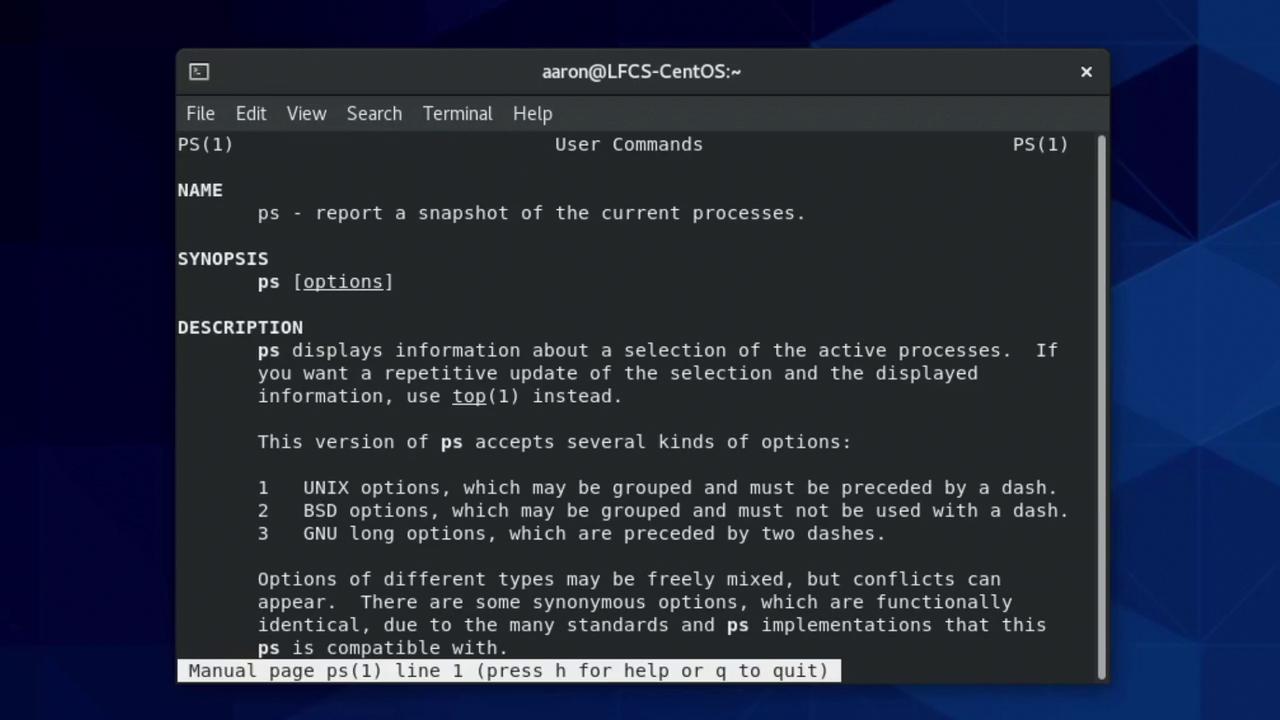Linux Professional Institute LPIC-1 Exam 101
GNU and Unix Commands
Create Monitor and Kill Processes
Understanding how to manage processes is fundamental for any Linux administrator. A process is simply a running instance of a program, from short-lived commands like ls to long-running services.
1. Launching a Process
For example, running:
[aaron@LFCS-CentOS ~]$ ls
absolute_picture_shortcut all_output.txt archive.tar archive.zip Desktop
Documents Downloads file1 file1.gz file2
file2.bz2 file3 file3.xz fstab_shortcut Music
nomachine_7.7.4_1_x86_64.rpm Pictures Public shortcut_to_directory
script.sh Templates testfile videos
[aaron@LFCS-CentOS ~]$
creates a short-lived ls process that exits once the directory contents are shown.
2. Inspecting Processes with ps
The ps command lists active processes. It has two distinct option styles:
| Syntax Style | Example | Description |
|---|---|---|
| UNIX-style | ps -e | Show every process |
| BSD-style | ps axu | All processes in user-oriented format |
To view all processes in a user-friendly layout, combine a (others’ processes), x (no controlling terminal), and u (user format):
ps aux
USER PID %CPU %MEM VSZ RSS TTY STAT START TIME COMMAND
root 1 0.0 0.3 241296 14000 ? Ss Mar23 0:01 /usr/lib/systemd/systemd
aaron 6601 6.2 4.8 3142460 185096 ? S 10:27 0:06 gnome-shell
… more …
2.1 Exploring ps Options

Common invocations from the manual:
- Full format
ps -ef # UNIX full format ps axu # BSD with user columns - Process tree
ps -ejH ps axjf - Thread details
ps -Elf ps axms
2.2 Understanding ps aux Columns
| Column | Description |
|---|---|
| USER | Process owner |
| PID | Process ID |
| %CPU | CPU usage at sample time |
| %MEM | Physical memory usage |
| VSZ | Virtual memory size (KB) |
| RSS | Resident Set Size (KB) |
| STAT | Process state |
| START | Start time or date |
| TIME | Cumulative CPU time |
| COMMAND | Command with arguments |
Note
Kernel threads run in kernel space and appear in square brackets, e.g., [kworker/0:1].
3. Real-Time Monitoring with top
To watch processes live:
top
top - 10:15:42 up 2:31, 1 user, load average: 0.01, 0.05, 0.03
Tasks: 236 total, 1 running, 235 sleeping, 0 stopped, 0 zombie
%Cpu(s): 0.5 us, 0.2 sy, 99.3 id, 0.0 wa, 0.0 hi, 0.0 si, 0.0 st
MiB Mem : 3731.4 total, 1588.9 free, 915.6 used, 1227.1 buff/cache
MiB Swap: 2048.0 total, 2048.0 free, 0.0 used. 2554.1 avail Mem
PID USER PR NI VIRT RES SHR S %CPU %MEM TIME+ COMMAND
6601 aaron 20 0 3142460 185096 104268 S 6.2 4.8 00:06.60 gnome-shell
1 root 20 0 241296 14000 8912 S 0.0 0.4 00:01.26 systemd
…
- Use arrow keys or Page Up/Page Down to navigate.
- Press
Qto quit.
4. Targeted Process Listings
| Task | Command |
|---|---|
| By PID | ps -p 1 or ps -p 1 -u |
| By user | ps -u aaron |
By name (with pgrep) | pgrep -a syslog |
# Find syslog processes:
pgrep -a syslog
# Kill them:
pkill -KILL syslog
5. Managing Process Priority (Niceness)
Niceness spans -20 (highest priority) to 19 (lowest). Lower niceness → higher scheduling priority.
5.1 Launching with nice
nice -n 11 bash
5.2 Viewing Niceness
ps -l | head -n 6
F UID PID PPID PRI NI VSZ RSS WCHAN STAT COMMAND
…
0 1000 6543 6540 20 0 658840 19268 – SL+ /usr/bin/gnome-shell
4 1000 6673 6669 20 11 302924 8516 – Sl bash
The NI column shows the niceness value.
5.3 Changing with renice
# Increase niceness (lower priority):
renice 15 6673
# Decrease niceness (requires sudo):
sudo renice -5 6673
6. Signals and kill
Linux uses signals to control processes:
| Signal | Number | Description |
|---|---|---|
| SIGHUP | 1 | Hangup/reload |
| SIGINT | 2 | Interrupt (Ctrl+C) |
| SIGTERM | 15 | Graceful shutdown |
| SIGKILL | 9 | Force kill (uncatchable) |
# List all signal names and numbers:
kill -l
You can omit the SIG prefix:
kill -s KILL 1234
kill -9 1234
kill 1234 # defaults to SIGTERM
Warning
Using SIGKILL (kill -9) does not allow cleanup and may leave resources in an inconsistent state. Use SIGTERM first.
Example: Restarting sshd
systemctl status sshd.service
sudo kill -SIGHUP 1147
systemctl status sshd.service
# sshd[1147]: Received SIGHUP; restarting.
7. Shell Job Control
| Action | Keystroke or Command |
|---|---|
| Interrupt (SIGINT) | Ctrl+C |
| Pause/Stop (SIGTSTP) | Ctrl+Z |
| Background a command | sleep 180 & |
| List jobs | jobs |
| Bring job to foreground | fg %1 |
| Resume in background | bg %1 |
8. Open Files with lsof
- List files opened by a PID:
lsof -p 8401 - Find which process holds a file:
sudo lsof /var/log/messages
Note
Use sudo when required to avoid permission denied errors.
That concludes our guide on creating, monitoring, and killing processes in Linux. Practice these commands in a lab environment to master process management.
Links and References
- ps(1) — Linux Manual Page
- top(1) — Linux Manual Page
- kill(1) — Linux Manual Page
- lsof(8) — Linux Manual Page
Watch Video
Watch video content